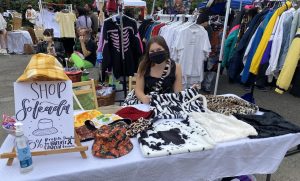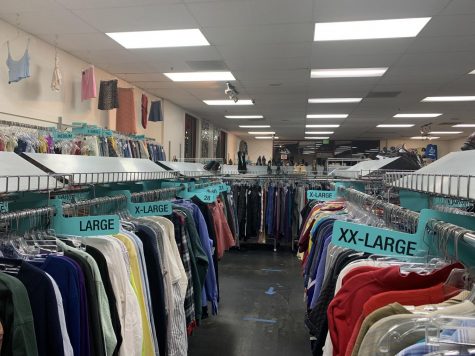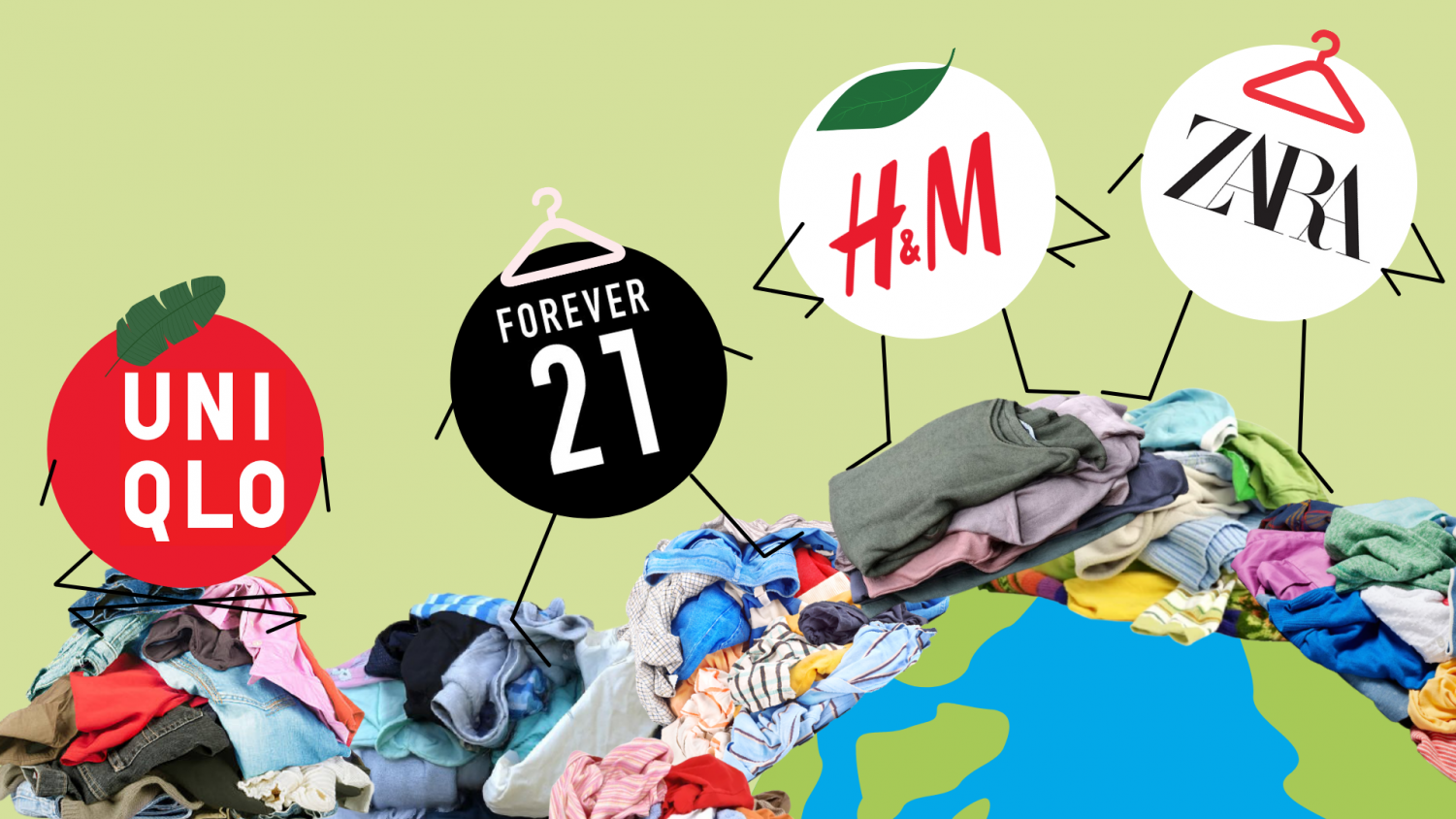Your donation will support the student journalists in the AVJournalism program. Your contribution will allow us to purchase equipment and cover our annual website hosting costs.
Gen Z’s style crisis
Fast fashion isn't just on the streets–it's on the rise.
Crop tops in August. Ripped jeans in October. And for December? Oversized hoodies and black beanies are trending throughout the quad.
Generation Z is known as the first wave of true digital natives. Born straight into the boom of the Internet, smartphone, and social media, teenagers have embraced living online from the start without a pause. But beyond a digital obsession, there’s another defining trait of Gen Z that most people overlook: the skyrocketing sales of fast fashion.
The Teen Shopper
Fast fashion is fast indeed. This new, incredibly fast model of production shook up the fashion industry when the then-still-unknown Zara pioneered it in 1989. A few decades ago, designer brands took an average of three months to bring a clothing design concept to the store rack. Now, companies like Shein and ASOS can debut hundreds of new pieces per week.
And it sure is working. Under the fast fashion umbrella resides many of the biggest and most profitable clothing titans of today. Nike, Brandy Melville, Forever 21, and more–these are the brands that dominate the modern high student’s shopping carts, brands whose slick operations and quick grasp of trends ushered in a new era of dizzying speed, “constant novelty,” and, ultimately, the rise of the beloved teen consumer.
Whether it’s in the form of Nike hoodies, LuluLemon leggings, or Urban Outfitters mini skirts, there’s no doubt fast fashion is a ubiquitous presence on campus.
In a survey conducted by Amador Valley Today, 77.5% of Amador students said they’ve bought from fast fashion brands, and 87.5% said some, most, or all of their friends regularly wear and buy such clothing.
With catalogues stuffed full with different products that run the gamut style-wise, fast fashion offers enough clothing to suit anyone’s taste. At Amador, for example, while Sean Smayra (‘23) and his friends prefer lounging in Nike and Adidas sports apparel, Eric Haltid (‘25) likes to “drip” hip-hop style in Lacoste and American Eagle.
However, the constant, daily refreshing of garments in stores promotes a culture of FOMO, or fear of missing out, among teens. Worried about missing the latest trends and enticed by the allure of popularity, Gen Z shoppers tend to purchase more clothes than they really need.
“[You want] to fit in, to look cool. Even though it may not be in the best quality, [fast fashion brands are] considered the ‘popular brands,’ so you want to wear them,” said Eoin Stapleton (‘25).
A brand’s name and reputation is commonly of greater concern than the actual quality or history behind the clothes sold. That’s why many students gravitate towards big-name stores like Brandy Melville and Forever 21 when making a purchase, since a recognizable and prolific brand name acts like a social stamp of approval and wealth.

Part of the driving force behind fast fashion’s boost in popularity is the growing prevalence of social media. On platforms like TikTok and YouTube, teenage fashion and beauty influencers frequently post large haul videos in which they display their abundant clothing purchases.
In one video, 22-year old influencer Kianna Naomi’s bedroom is almost entirely covered under piles of shopping bags and garments.
“Did I need this? No. I just think it’s amazing,” said Naomi, flicking through her purchases.
When teens watch these videos, they assume that they need to own more clothes and subconsciously attribute cycling through the same clothes as “uncool.” Even celebrities take care to appear in different clothes in public, contributing to the social stigma around outfit-repeating.
“If you wear the same clothes every day, people are like, ‘Oh, how many clothes do you have?’ And you don’t want that question to be asked. So obviously you’re going to buy more clothes, try to fit in, maybe even not just fit in [but] be more popular,” said Regina Rajbanshi (‘23).
The Conscious Consumer
Despite the fact that Gen Z identifies as the most environmentally-conscious generation, most teenagers are unaware about the ways to spot a fast fashion brand while shopping in the store.
Our survey of students at Amador revealed that 7 out of every 10 students either didn’t know any sustainable clothing brands or weren’t sure if the brands they knew were sustainable. This inability to identify fast fashion brands as fast fashion was backed up when we later asked students to choose from a list of nine popular brands the ones they counted as fast fashion.
The twist? All of the listed companies were well-known fast fashion conglomerates. While most respondents accurately recognized infamous staples like Forever 21 or Shein, they made more incorrect judgments when it came to other popular teenage brands, like American Eagle, Urban Outfitters, and Nike. Their wrong judgements doesn’t tell against them, but it shows that students are less likely to consider a company fast fashion when they themselves buy from there.
“I do see some people engaging in shopping in fast fashion, but most of my friend group just tends to wear athletic wear or hoodies from places like Nike, just typical stuff,” said Aarav Kakad (‘24).
Honing one’s fast fashion detector is hard. If you’re dealing with a well-established shop, you might find its name on lists of fast fashion companies compiled by blogs like Minimalism Simple and Sustainably Chic, or the ethical shopping app Good on You. For most, though, researching beforehand is an impractical approach when it comes to shopping in real life.
“I just get whatever I like… If I am downtown and something catches my eye, then I might go in there, or sometimes I’ll shop online if there’s something specific that I’m looking for. It depends, but I try not to shop at those really big, fast fashion brands,” said Alana Hicks (‘24).
That said, there are several red flags that make a fast fashion company stand out from the crowd. When you’re shopping in person, the tell-tale signs revolve around closely examining the cost, materials, and production location of the clothes they offer.
Online, unethical companies hide their tracks better. It takes more fastidious digging through a company’s website to determine their sustainability status. Sowers, a seasoned veteran in such matters, recommends searching websites for the more human aspects of a brand, like profiles on business owners or executives.
“[This] gives a key inside the morals [companies] value, and then you can extend that to the choices they would make on sustainability,” said Sowers. “It’s almost like finding the legitimacy of a website extends to the same thing [as] the business.”
Staying Sustainable
Three years ago, when H&M came under fire for their mistreatment of workers and poor labor conditions, Sowers decided she wouldn’t shop there anymore. But after looking more into the issue with her mother, Sowers realized the underlying problem wasn’t just with H&M, but within the inner workings of the fast fashion industry itself.
“[That’s] when I really started to shift my mindset. I think it’s common that people go to these big brands and big companies because they’re what’s convenient, when in reality, your singular impact can definitely have more of a lasting effect than you’d ever think,” said Sowers.
Instead of heading to the mall for new batches of clothes, consider buying from online second-hand dealers like ThredUp or Depop. These platforms emulate the quick browsing experience that comes with online shopping, which makes thrifting just as accessible and easy as buying from fast fashion stores.
In a surprising twist, designer items and fast fashion clothing can often find their way into thrifting communities like ThredUp, which is how Smith ended up bagging a deluxe Coach purse for just $30.
In her eyes, the thrill of thrift shopping lies in the unpredictability of what one will end up purchasing and the greater personal customization one can enjoy.

“It’s more fun to go thrifting because you’re more able to put your own fashion and own sense of style into it, instead of just going along with the [existing] trends and doing what’s new,” said Smith.
The founder of Shop Soleada, an online business that sells handmade bucket hats and tote bags, Smith urges teens to support smaller shops and local thrift stores that are transparent about their clothing policies. These alternatives allow customers to revive unwanted, second-hand garments and reduce the large amount of clothing dumped in landfills.
“By shopping from small brands, you know where your products are coming from, you know it’s good quality, you know you’re not exploiting people from different countries for different resources,” said Smith. “It’s important to actually go to sustainable brands you know are actually coming from good places and are not using environmental reasons to get you to shop there.”
Sowers currently works at a store called Girlfriends Boutique based in downtown Pleasanton. Her experience at Girlfriends opened her eyes to how the fast fashion industry can harm local businesses.
“When you choose to buy from a business that works unsustainably, you’re not only supporting their contribution to the pollution of the environment, but you’re also taking away money that could be what’s helping a local business owner make a living,” said Sower.
What’s even more important than where you shop is how you treat your clothes. Before buying something new, seeing if you can repurpose or alter something you already own is the perfect solution to over-aggressive consumerism.

“I usually wear [my clothes] for a few years… Once they get old, I just wear them at home and I sleep in them. If they tear or rip badly, then I chuck them or donate them if they’re not horribly ripped,” said Anya Srinivasan (‘24).
In addition to extending the life cycle of one’s clothes, thrift flips offer plenty of creative ideas for transforming old clothing into something new and stylish. YouTube creators like Ashley Rous from Bestdressed and Wendy Liu from withwendy used their platforms to teach and promote altering and tailoring one’s old clothes to a better fit.
Ultimately, to become a more conscious consumer, teenagers need to educate themselves more on the problems and issues tied to fast fashion.
“We’re in a pretty cool time in our lives where we’re developing our own identity and sense of self, and [we should be] taking advantage of that to realize that… you don’t need to follow the norm, [and] if everyone shops at that one place it doesn’t mean you need to shop there too,” said Sower. “[Once you] realize what you do has an impact, I think the rest kind of follows.”
